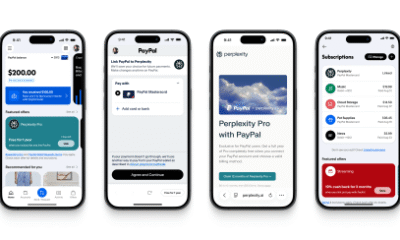Tools & Platforms
AI hallucinations: Retail technology experts sound off on the risks – Automotive News

Tools & Platforms
AI and Tech Empowering a New Generation of Traders

Artificial intelligence is no longer just a buzzword in finance — it’s the beating heart of the next generation of trading. But here’s the truth: the smartest algorithm in the world is only as powerful as the hardware it runs on. That’s where Marlinn Group is making its mark, bringing together bleeding-edge infrastructure and proprietary AI models to power its Marlinn Aggregator Pricing Bot (MAPB).
Hardware Meets Trading Intelligence
At the core of MAPB sits a custom AI stack built on:
NVIDIA Blackwell B200 & AMD MI300X GPUs — delivering the ultra-fast compute power needed to run transformer models in real time.
32TB LPDDR6 RAM & Intel Xeon Max CPUs — enabling parallel analysis of thousands of blockchain events per second.
Sub-microsecond execution relays via EigenLayer and Flashbots — ensuring trades settle faster than the competition.
This is not abstract capability — it’s raw horsepower that directly translates into profitable trades. While Nvidia’s own stock hovers around $172–174 per share, reflecting the global demand for AI infrastructure, Marlinn is putting that hardware to work in a way few others can: turning compute into capital.
MAPB in Action: Use Cases That Matter
Predicting the Future, Not Just the Present
Through its Quantum Predictive Mempool Intelligence, MAPB forecasts upcoming mempool patterns — not just pending transactions, but likely clusters of behavior. For traders, that means seeing the market’s next move before it happens.
Cross-Chain Capital Flow Without Friction
With its Autonomous Capital Routing Engine (ACRE), MAPB pulls liquidity across multiple blockchains in real time. Zero-knowledge bridges and Layer-2 rollups ensure trades execute atomically, without the risk of slippage or failed swaps.
Gas Efficiency as an Edge
Gas wars are often the difference between profit and loss. MAPB’s Neural Gas Fee Intelligence (NGFI) analyses congestion, validator behaviour, and time-of-day cycles, recalibrating fees at millisecond latency. Traders pay less, execute faster, and keep more of their profit.
Security That Evolves With the Threats

Why This Matters for Traders
Marlinn has already demonstrated MAPB’s consistency with a record of 98.2% profitable trades, and scalability that can cover 5–7.5% of the entire decentralized market trading volume. Combined with fast revenue distribution to account holders and fully auditable on-chain records, MAPB offers not just technology — but trust.
Riyan Verma, Marlinn’s Technology Director, sums it up best:
“The extraordinary gains in AI today aren’t possible without high-throughput infrastructure. Our integration of Blackwell, MI300X, and LPDDR6 memory empowers MAPB to predict, execute, and secure trades in ways the mainstream hasn’t seen yet. This is how we turn cutting-edge technology into real, measurable advantage for traders.”
The Future of AI in Trading
For Marlinn, this isn’t about chasing hype. It’s about building the blueprint for tomorrow’s financial infrastructure — where foresight, velocity, and security define profitability. In a world where milliseconds separate winners from losers, MAPB and its AI-driven hardware backbone are empowering a new generation of traders to stay ahead of the curve.
MAPB doesn’t just detect arbitrage; it defends itself. With the Zero-Knowledge Frontrun Shield (ZK-FS), proprietary trade logic is protected from competitors, while Self-Healing Smart Contracts patch vulnerabilities in real time, keeping capital safe.
Media Contact
Company Name: Marlinn Group
Contact Person: Media Manager
Email: Send Email
Country: United States
Website: www.marlinn.io
Tools & Platforms
AI and Tech Empowering a New Generation of Traders

Artificial intelligence is no longer just a buzzword in finance — it’s the beating heart of the next generation of trading. But here’s the truth: the smartest algorithm in the world is only as powerful as the hardware it runs on. That’s where Marlinn Group is making its mark, bringing together bleeding-edge infrastructure and proprietary AI models to power its Marlinn Aggregator Pricing Bot (MAPB).
Hardware Meets Trading Intelligence
At the core of MAPB sits a custom AI stack built on:
NVIDIA Blackwell B200 & AMD MI300X GPUs — delivering the ultra-fast compute power needed to run transformer models in real time.
32TB LPDDR6 RAM & Intel Xeon Max CPUs — enabling parallel analysis of thousands of blockchain events per second.
Sub-microsecond execution relays via EigenLayer and Flashbots — ensuring trades settle faster than the competition.
This is not abstract capability — it’s raw horsepower that directly translates into profitable trades. While Nvidia’s own stock hovers around $172–174 per share, reflecting the global demand for AI infrastructure, Marlinn is putting that hardware to work in a way few others can: turning compute into capital.
MAPB in Action: Use Cases That Matter
Predicting the Future, Not Just the Present
Through its Quantum Predictive Mempool Intelligence, MAPB forecasts upcoming mempool patterns — not just pending transactions, but likely clusters of behavior. For traders, that means seeing the market’s next move before it happens.
Cross-Chain Capital Flow Without Friction
With its Autonomous Capital Routing Engine (ACRE), MAPB pulls liquidity across multiple blockchains in real time. Zero-knowledge bridges and Layer-2 rollups ensure trades execute atomically, without the risk of slippage or failed swaps.
Gas Efficiency as an Edge
Gas wars are often the difference between profit and loss. MAPB’s Neural Gas Fee Intelligence (NGFI) analyses congestion, validator behaviour, and time-of-day cycles, recalibrating fees at millisecond latency. Traders pay less, execute faster, and keep more of their profit.
Security That Evolves With the Threats

Why This Matters for Traders
Marlinn has already demonstrated MAPB’s consistency with a record of 98.2% profitable trades, and scalability that can cover 5–7.5% of the entire decentralized market trading volume. Combined with fast revenue distribution to account holders and fully auditable on-chain records, MAPB offers not just technology — but trust.
Riyan Verma, Marlinn’s Technology Director, sums it up best:
“The extraordinary gains in AI today aren’t possible without high-throughput infrastructure. Our integration of Blackwell, MI300X, and LPDDR6 memory empowers MAPB to predict, execute, and secure trades in ways the mainstream hasn’t seen yet. This is how we turn cutting-edge technology into real, measurable advantage for traders.”
The Future of AI in Trading
For Marlinn, this isn’t about chasing hype. It’s about building the blueprint for tomorrow’s financial infrastructure — where foresight, velocity, and security define profitability. In a world where milliseconds separate winners from losers, MAPB and its AI-driven hardware backbone are empowering a new generation of traders to stay ahead of the curve.
MAPB doesn’t just detect arbitrage; it defends itself. With the Zero-Knowledge Frontrun Shield (ZK-FS), proprietary trade logic is protected from competitors, while Self-Healing Smart Contracts patch vulnerabilities in real time, keeping capital safe.
Media Contact
Company Name: Marlinn Group
Contact Person: Media Manager
Email: Send Email
Country: United States
Website: www.marlinn.io
Tools & Platforms
Tech Giants Push Policy Power

Vice President JD Vance speaks in Washington, DC., during the 2025 American Dynamism Summit on March 18, 2025, hosted by the venture capital firm Andreessen Horowitz (a16z).
Getty Images
A group of tech leaders and artificial intelligence companies announced the creation of Leading the Future (LTF), a new organization designed to, in its words, “ensure the United States remains the global leader in AI by advancing a clear, high-level policy agenda at the federal and state levels and serving as the political and policy center of gravity for the AI industry.” The industry is no longer happy to shape policy through think tanks, white papers, and voluntary commitments. It is building a political influence infrastructure.
Who Is Behind LTF
The coalition includes powerful venture capital firms like Andreessen Horowitz, investors such as Ron Conway (one of Silicon Valley’s super angels with early investments in Facebook, Google, Airbnb and Reddit), Joe Lonsdale (Palantir cofounder and an early executive at Clarium Capital, Peter Thiel’s hedge fund), Greg Brockman (OpenAI cofounder and current president) and his wife Anna Brockman. Even though the announcement is short on specific names, it indicates the participation from leading firms, including Perplexity.
Their motivations are clear in their intent to promote policies to advance the economic benefits of the technology and oppose efforts seen as limiting and delaying its development in the US. They frame the stakes in AI as not only commercial but also geopolitical. With Washington and Beijing locked in a struggle over compute power, export controls, and data supply chains, tech leaders want a direct line into state capitals and the halls of Congress.
Earlier lobbying by the internet sector focused on shaping policy through public campaigns, portraying themselves as defenders of the users, internet freedom or innovation. They often leaned on trade associations. Differently, LTF brands itself as an independent political entity. The initiative is a well-funded, centralized advocacy effort positioned to shape the future direction of tech policy in the country. It resembles historical efforts in business, food, tobacco, pharma, and other sectors with well-coordinated lobbying and electioneering to secure favorable outcomes.
Lessons from Web 2.0
This is not the first time Silicon Valley has built influence in Washington. In the late 2000s, as regulators debated privacy, antitrust, and liability protections, internet companies expanded their lobbying spend. Google went from negligible activity in the early 2000s to being among the top corporate lobbyists by the early 2010s. Facebook followed suit, building networks of state and federal lobbyists while fighting attempts to tighten rules on data collection.
Those efforts were defensive, aimed at forestalling oversight that might slow growth. Silicon Valley’s attitude toward Washington during Web 2.0 was generally one of avoidance, with tech leaders’ preference for minimal governance and free-market growth. Most companies neglected formal lobbying until faced with scrutiny, potential regulation or in response to crises. The relationship was characterized by mutual unfamiliarity, with many in DC underestimating the tech sector’s potential impact on policy, and tech companies believing they could bypass government oversight by focusing solely on innovation.
By contrast, LTF presents itself as offensive: it wants to shape an affirmative agenda and frame the policy debate itself.
Regulatory Capture and AI
Economists and legal scholars have long warned about the dangers of industries capturing the agencies tasked with regulating them. George Stigler, in his seminal 1971 essay The Theory of Economic Regulation, argued that “as a rule, regulation is acquired by the industry and is designed and operated primarily for its benefit”. He introduced the concept of regulatory capture and shifted the understanding of regulation from the public interest model to a rational business choice. One of his insights was that companies often prefer regulatory control over subsidies. Rules that restrict entry, shape market structure, or favor complements can create more lasting advantage than direct government handouts.
Stephen Breyer, writing in Regulation and Its Reform (1984), documented the recurring pattern of regulatory failure in America: high costs, low returns, procedural gridlock, and unpredictability. Cass Sunstein added a twist in his 1990 essay Paradoxes of the Regulatory State: sometimes well-intentioned regulation backfires, producing the opposite of its intended effect.
Silicon Valley Bank’s 2023 collapse, the second largest in U.S. history, resulted from risky management, overinvestment in long-term bonds losing value as rates rose, and a rapid $42 billion bank run. This crisis is an example of how regulatory capture and policy changes, like the post-2018 rollback of Dodd-Frank provisions, can backfire. Regulatory failures included delayed, insufficient oversight due to weakened post-2018 rules, procedural gridlock, and unpredictability.
These perspectives suggest that as AI evolves, the risk is not just over- or under-regulation, but that industry itself will be the architect of the rules. AI offers fertile ground for capture. The technology is complex, opaque, and evolving quickly. Regulators often lack the expertise or resources to challenge the claims of leading labs. This creates an asymmetry: the firms that dominate model training are also those most capable of defining the safety benchmarks, compliance metrics, and standards of responsible AI.
Money in Politics Today
The timing of LTF’s launch is no accident. The Supreme Court’s Citizens United decision in 2010 opened the door to unlimited corporate spending on political speech through Super PACs and 501(c)(4) “social welfare” groups. These entities can raise and spend vast sums, often with limited transparency. Tech leaders are familiar with these vehicles, and crypto companies have used them aggressively in the 2024 election cycle.
By creating LTF as a political hub, the sector signals it intends to play at the same level as defense contractors, pharmaceutical giants, and oil companies. The group can funnel money into congressional races, shape ballot initiatives, and build permanent influence networks. And because AI touches multiple policy domains—national security, labor, education, healthcare—the scope of lobbying is potentially broader than any prior technology sector campaign.
The sums at stake are enormous. Training frontier models requires billions of dollars in chips and energy. Securing government contracts for AI in defense, intelligence, and healthcare could yield recurring revenue streams. In this context, spending hundreds of millions on political influence is rational, and perhaps necessary, for firms seeking to entrench their market position.
Possible Futures for AI Policy
The creation of LTF raises the question: Is AI governance going to follow a pattern of capture, or can policymakers create structures to resist it?
On one path, industry sets the rules. Companies use their clout to define the pathways that align with their business models. They shape federal preemption laws that limit state experimentation. They fund think tanks and university programs that validate their frameworks. This would mirror what Stigler described as the normal course of regulation: industries acquiring and shaping the state’s coercive power for their own benefit.
On another path, policymakers build more resilient institutions. Breyer’s framework suggests starting with clear objectives, examining alternative methods, and choosing the least intrusive regulatory form. Sunstein warns against paradoxes, where well-meaning but rigid rules lead to enforcement paralysis. Applied to AI, this means balancing innovation with safeguards, ensuring that agencies have the expertise to evaluate claims, and creating accountability mechanisms that cannot be dominated by a handful of firms.
Will AI policy become another case study in capture or a demonstration that democratic institutions can adapt to a general-purpose technology? From railroads to telecoms to energy, industries with concentrated wealth and technical expertise have usually succeeded in bending rules to their favor. But AI also raises existential concerns, from misinformation to labor disruption to military use, that broaden the coalition demanding oversight.
The launch of Leading the Future formalizes what had been implicit: AI is not just a technological race but also a contest over policy and influence. The outcome will depend on whether policymakers heed the lessons of Breyer, Stigler, and Sunstein or repeat the familiar cycle of regulation designed by and for the regulated.
Money will play a decisive role, as it always has in American politics. But the stakes in AI are larger than market share.
-

 Business5 days ago
Business5 days agoThe Guardian view on Trump and the Fed: independence is no substitute for accountability | Editorial
-
Tools & Platforms3 weeks ago
Building Trust in Military AI Starts with Opening the Black Box – War on the Rocks
-

 Ethics & Policy1 month ago
Ethics & Policy1 month agoSDAIA Supports Saudi Arabia’s Leadership in Shaping Global AI Ethics, Policy, and Research – وكالة الأنباء السعودية
-

 Events & Conferences4 months ago
Events & Conferences4 months agoJourney to 1000 models: Scaling Instagram’s recommendation system
-

 Jobs & Careers2 months ago
Jobs & Careers2 months agoMumbai-based Perplexity Alternative Has 60k+ Users Without Funding
-

 Education2 months ago
Education2 months agoVEX Robotics launches AI-powered classroom robotics system
-

 Funding & Business2 months ago
Funding & Business2 months agoKayak and Expedia race to build AI travel agents that turn social posts into itineraries
-

 Podcasts & Talks2 months ago
Podcasts & Talks2 months agoHappy 4th of July! 🎆 Made with Veo 3 in Gemini
-

 Podcasts & Talks2 months ago
Podcasts & Talks2 months agoOpenAI 🤝 @teamganassi
-

 Education2 months ago
Education2 months agoMacron says UK and France have duty to tackle illegal migration ‘with humanity, solidarity and firmness’ – UK politics live | Politics



















